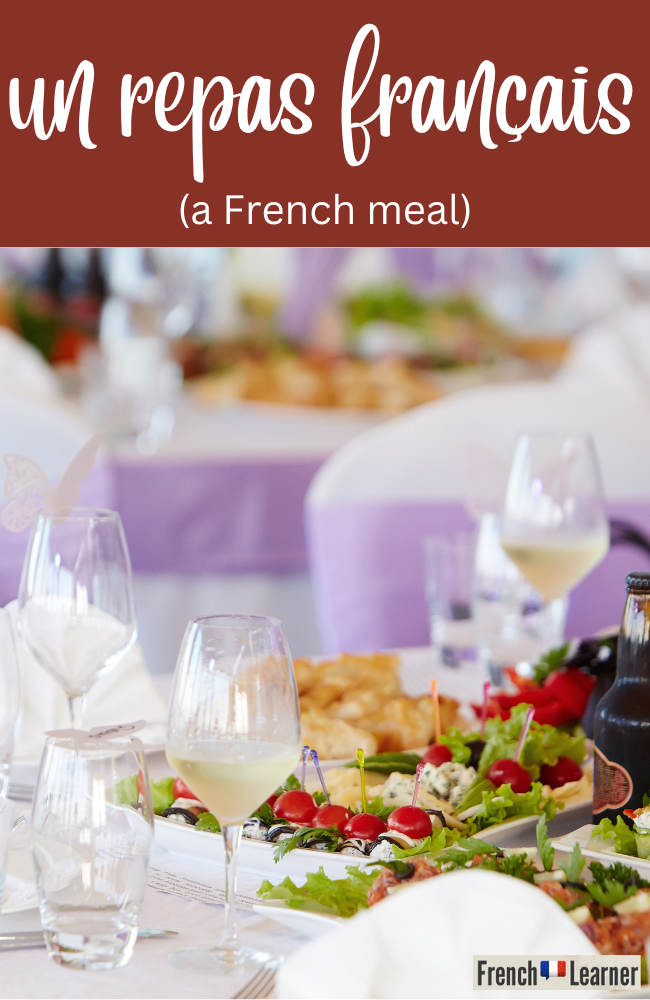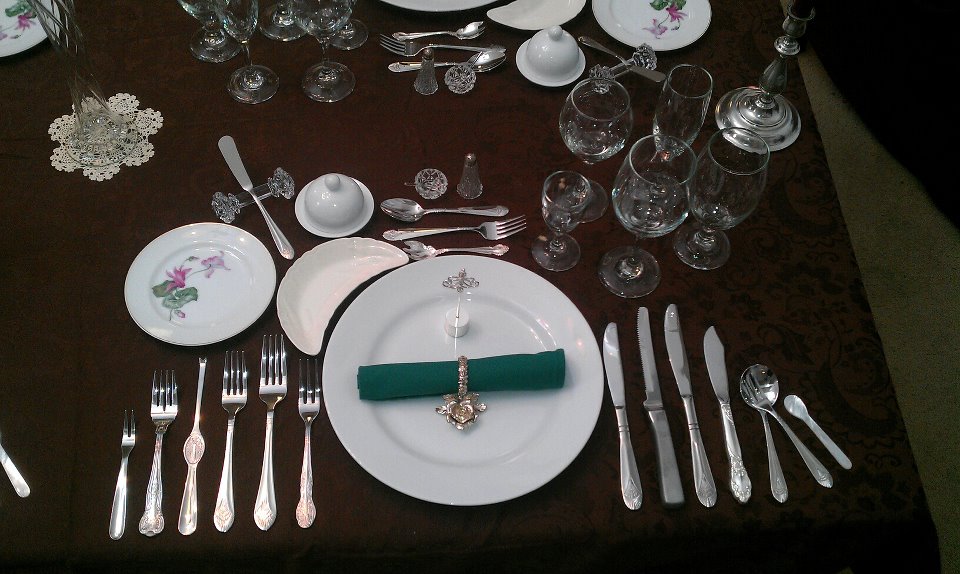If you happen to find yourself sitting at the table a French family, you’ll quickly realize the importance of knowing French table manners. Indeed, there are several aspects to French table etiquette that are much different from in the United States. This post will show you precisely how to conduct yourself at a French table.

Guide To Dining Etiquette In France
Get ready for marathon meals
In France French culture, dining around the table as a family or group is very important. People in France spend much more time at the table than in the United States.
Meal time in France is a time for joyful conversation and enjoying high-quality food. French meals include many servings and can last many hours.
A typical French dinner will start at around 8:00pm and often run over 11:00pm. The meal will start with a taken as a group called apéritif. This is when the French like to “moisten the lips” (mouiller les lèvres).
Then, the meal will often consists of many courses, with the host and hostess coming in an out of the kitchen. There is almost always by default a soup and salad, with salad being served after the main course. Try not to fill up too much because cheese plate and dessert are amazing 100% of the time!
Knowing what to do and not to do is essential if you find yourself sitting at a French table. The lack of knowledge of these basic manners could possibly make you look like a “stupid American” in the eyes of the French.

French table manners: How to appear respectable chez les français
1. Don’t show up empty-handed
Similar to North America, it is considered impolite to show up as a guest at somebody’s house empty-handed. The best situation is to bring some sort of treat from the area where you’re from. The French might be snobbish about their own cuisine, but they still love trying new things!
You can always bring a bottle of wine or another type of alcohol. It might be a good idea to ask the clerk at the store to make sure you’re bringing a quality bottle and not some cheap vin de table (table wine).
2. Respect the hosts’ seating arrangements
Always wait for the hostess to show you your seat. Upon arrival at a French home, it is considered impolite to just sit wherever you want at the table.
Traditionally, it’s the hostess who indicates where each guests sit. Often important guests and older attendees of the meal sit closest to the hosts, with younger people sitting further away.
Whenever possible, the hostess will often sit men and women alternating each other.
Traditionally, the host and hostess sit at opposite ends of the table facing each other. If the meal is for an engagement or wedding, the couple often sits at the head of the table.
3. Apply basic manners you learned as a child
Of course it goes without saying that it’s crucial to apply the basic table manners in France that you learned as a child. This includes not chewing loudly, not chewing with your mouth open, not burping loudly and not reaching your hands over other guests at the table.
One of the single worst things you when dining with the French is putting your elbows on the table and/or resting your head in your hands. This is probably the single biggest faux pas at a French table.
Also, do not hang your napkin from the top of your shirt like a bib. This practice is reserved for children only and make you look like a fool! The napkin should and must be placed on your lap, just like in the United States or Canada.
4. Don’t bite directly into the bread
The French often eat bread with their meals. The bread may be served sliced or you may tear off a piece. It is considered very impolite to bite directly into your piece of bread.
Break bite-size morsels off of the bigger piece and pop those into your mouth. You may also use the bread to “mop” up sauces form your plate.
In addition, don’t expect to see butter on the table for the bread. In France, bread is eaten with butter but only during breakfast.

5. Avoid asking for seconds
In North America is very customary to ask for seconds as it show the host you liked the dish. In France, however, this might be considered gourmand (piggish).
Enjoy what you’re served and tell the host it’s délicieux. Generally speaking, there is so much food on offer at a French meal that it’s unnecessary to ask for seconds.
6. Keep both arms on the table
It is considered impolite to keep a hand below the table on your thigh. In North America, it customary to rest one hand on your thigh when eating and only raise the left hand (if you’re a righty) to use the knife. In France, however, it is customary to eat with both hands and forearms on the table.
This is the “continental” style of eating, where the knife is held in the left hand and pushes food onto the fork, which is held in the right hand in a downward position.
7. Don’t put used silverware on the tablecloth
If you need to use your hands during the meal, place used silverware on your plate and directly onto the tablecloth. This avoids unnecessary stains.
8. Use silverware from the outside moving in
In France, it is very common to find multiple sets of silverware at your place setting. The rule of thumb is to use the silverware from the outside moving inward for each course. If you don’t know which silverware to use, you may politely ask the people around you.
When finished with a dish or course, place the silverware on this dish. Do not place used silverware on the edge of the dish. This lets the hosts know that you’ve finished the particular course in question.

9. Do not cut lettuce leaves or pasta
North Americans commonly use the knife to cut lettuce leaves and pasta. In France, however, this is considered impolite. Use the knife in the left hand to fold the salad leaves on to the fork.
Do not cut the pasta. When eating pasta, you’ll be given a larger spoon. Take some pasta with the fork and twirl it using the spoon. If you’re not sure how to do this just watch the people around you.
10. Avoid saying thank you too many times
Try to avoid over usage of the word merci when sitting at the French table. It will appear as awkward to the host or hostess if you keep repeatedly thanking them at each turn during the evening.
Saying thank you too much could be considered overbearing. Just thank them a few times during evening and everybody will be happy.
Conclusion
We hope these few lines on French table manners have helped. Remember, as a visitor the French will cut you some slack and not expect your to know all the customs. However, we feel that if you know the basics you’ll probably feel more at ease with your new amis français (French friends).
Discover more:
- How to use the expression “bon appétit”
- How to order a meal in a restaurant
- French food vocabulary
- Top 10 French foods
- Top 10 French cheeses
- Top 10 French desserts

